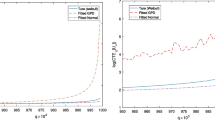Abstract
This paper proposes a new insurance model, called More for Less, as an alternative to (re)insurance. Briefly, the company charges more premiums than necessary from the insured, but it undertakes to reimburse part of them if there has been no claim. Our goal is to compare this model to a (re)insurance model by examining the finite-time ruin probabilities and the expected deficit at ruin. The approach adopted here is based on simple calculations of path integrals and properties of an underlying family of Sheffer polynomials. The main motivation is to offer a different insurance coverage in today’s changing world.
Similar content being viewed by others
References
Albrecher H, Beirlant J, Teugels JL (2017) Reinsurance: actuarial and statistical aspects. Wiley, Hoboken
Asmussen S, Albrecher H (2010) Ruin probabilities. World Scientific, Singapore
Castañer A, Claramunt MM, Lefèvre C, Gathy M, Mármol M (2013) Ruin problems for a discrete time risk model with non-homogeneous conditions. Scand Actuar J 2:83–102
De Vylder FE (1999) Numerical finite-time ruin probabilities by the Picard–Lefèvre formula. Scand Actuar J 2:97–105
Di Bucchianico A (1997) Probabilistic and analytical aspects of the umbral calculus. Centrum voor Wiskunde en Informatica, CWI Tracts 119, Amsterdam
Dickson DCM (2007) Some finite time ruin problems. Ann Actuarial Sci 2:217–232
Dickson DCM (2017) Insurance risk and ruin, 2nd edn. Cambridge University Press, Cambridge
Dimitrova DS, Ignatov ZG, Kaishev VK (2019) Ruin and deficit under claim arrivals with the order statistics property. Methodol Comput Appl Probab 21:511–530
Donnelly C, Gerrard R, Guillén M, Nielsen JP (2015) Less is more: increasing retirement gains by using an upside terminal wealth constraint. Insurance Math Econom 64:259–267
Feynman RP, Hibbs AR (2010) Quantum Mechanics and Path Integrals (emended edition by D.F. Styer). Dover Editions, New York
Gerber HU, Shiu ES (1997) The joint distribution of the time of ruin, the surplus immediately before ruin, and the deficit at ruin. Insurance Math Econom 21:129–137
Goffard P-O, Lefèvre C (2018) Duality in ruin problems for ordered risk models. Insurance Math Econom 78:44–52
Gorge G (2016) Insurance risk management and reinsurance, 2nd edn. Lulu.com, Raleigh
Hao W, Lefèvre C, Tamturk M, Utev S (2019) Quantum option pricing and data analysis. J Quant Finance Econ 3:490–507
Ignatov ZG, Kaishev VK (2004) A finite-time ruin probability formula for continuous claim severities. J Appl Probab 41:570–578
Lefèvre C, Loisel S (2009) Finite-time ruin probabilities for discrete, possibly dependent, claim severities. Methodol Comput Appl Probab 11:425–441
Lefèvre C, Picard P (2006) A nonhomogeneous risk model for insurance. Comput Math Appl 51:325–334
Lefèvre C, Picard P (2014) Appell pseudopolynomials and Erlang-type risk models. Stochast Int: J Probab Stochast Process 86:676–695
Lefèvre C, Picard P (2015) Risk models in insurance and epidemics: A bridge through randomized polynomials. Probab Eng Inf Sci 29:399–420
Lefèvre C, Loisel S, Tamturk M, Utev S (2018) A quantum-type approach to non-life insurance risk modelling. Risks 6:1–17
Lin XS, Willmot GE (2000) The moments of the time of ruin, the surplus before ruin, and the deficit at ruin. Insurance Math Econom 27:19–44
Nie C, Dickson DC, Li S (2011) Minimizing the ruin probability through capital injections. Ann Actuar Sci 5:195–209
Nie C, Dickson DC, Li S (2015) The finite time ruin probability in a risk model with capital injections. Scand Actuar J 4:301–318
Niederhausen H (1981) Sheffer polynomials for computing exact Kolmogorov-Smirnov and Rényi type distributions. Ann Stat 9:923–944
Niederhausen H (2010) Finite operator calculus with applications to linear recursions. Available at http://math.fau.edu/Niederhausen/HTML/Research/UmbralCalculus/bookS2010.pdf. Project book
Panjer HH (1981) Recursive evaluation of a family of compound distributions. Astin Bull 12:22–26
Picard P, Lefèvre C (1997) The probability of ruin in finite time with discrete claim size distribution. Scand Actuar J 1:58–69
Roman S (1984) The umbral calculus. Academic Press, Orlando
Rullière D, Loisel S (2004) Another look at the Picard-Lefèvre formula for finite-time ruin probabilities. Insurance Math Econom 35:187–203
Schmidli H (2018) Risk theory. Springer, Cham
Tamturk M (2018) Ruin probability via several numerical methods. Doctoral Dissertation, University of Leicester
Tamturk M, Utev S (2018) Ruin probability via quantum mechanics approach. Insurance Math Econom 79:69–74
Tamturk M, Utev S (2019) Optimal reinsurance via Dirac–Feynman approach. Methodol Comput Appl Probab 21:647–659
Zacks S (2017) Sample path analysis and distributions of boundary crossing times. Springer, Cham
Zhang Z, Cheung E, Yang H (2018) On the compound Poisson risk model with periodic capital injections. Astin Bull 48:435–477
Acknowledgements
It is a real honor and pleasure for us to contribute to the Special Issue of JSTP in memory of Professor Theophilos N. Cacoullos.
We thank the Editors and Referees for their valuable comments and advice. We also thank Professor S. Utev (University of Leicester) for many helpful discussions.
The work of C. Lefèvre was conducted within the research chair DIALog under the aegis of the Risk Foundation, an initiative of CNP Assurances.
Author information
Authors and Affiliations
Corresponding author
Ethics declarations
Conflict of interest
On behalf of all authors, the corresponding author states that there is no conflict of interest.
Additional information
Publisher's Note
Springer Nature remains neutral with regard to jurisdictional claims in published maps and institutional affiliations.
This article is part of the topical collection “Advances in Probability and Statistics: an Issue in Memory of Theophilos Cacoullos” Guest edited by Narayanaswamy Balakrishnan, Charalambos. Charalambides, Tasos Christofides, Markos Koutras, and Simos Meintanis.
Rights and permissions
Springer Nature or its licensor holds exclusive rights to this article under a publishing agreement with the author(s) or other rightsholder(s); author self-archiving of the accepted manuscript version of this article is solely governed by the terms of such publishing agreement and applicable law.
About this article
Cite this article
Lefèvre, C., Tamturk, M. More for Less Insurance Model: An Alternative to (re)Insurance. J Stat Theory Pract 16, 64 (2022). https://doi.org/10.1007/s42519-022-00286-4
Accepted:
Published:
DOI: https://doi.org/10.1007/s42519-022-00286-4



